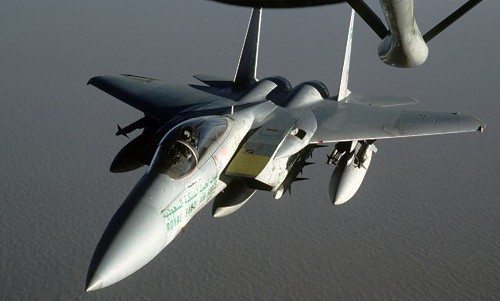While the news coming out of the Middle East over the past year has focused upon the percolations of restless societies, two aspects remain consistent amidst the region’s sea of political unrest: strong levels of investment in security forces and the appetite for defense-related acquisitions. The market for arms sales in the Middle East continues to be robust, notwithstanding the relative shift in security focus from external to internal concerns.
The region’s Arab nations, particularly those in the energy-rich Gulf, remain avid buyers of military hardware. In its latest Middle East market analysis, Forecast International anticipates that the six Gulf Cooperation Council (GCC) members will combine to spend $385 billion toward defense and security through 2016. Over the same period, Iraq is expected to invest $65 billion in its security forces.
With the Middle East accounting for about 20 percent of the world’s arms imports during the latter half of the previous decade, arms producers increasingly set their sites on this lucrative market. The rise in regional arms purchases corresponded with several developments in the security environment of the Arabian Peninsula. These included an increasingly assertive Iranian regional posture, a spike in oil prices that topped out at $147 per barrel in July 2008, and energy infrastructure concerns heightened by a failed terrorist attack on Saudi Arabia’s Abqaiq oil-processing facility in 2006.
Today, military modernization programs that include expansions in air, air-defense and naval capabilities are the principal drivers of procurement policy in the GCC states. Cushioned from the drop in international oil prices between late 2008 and mid-2010 by their sovereign wealth funds, the GCC members – led by Saudi Arabia and the United Arab Emirates – have continued to invest in weaponry and advanced platforms, with little sign of a slowdown.
With oil prices now hovering around $100 per barrel and security anxieties in several Gulf Arab kingdoms heightened, there is little reason to expect a slowdown in the defense procurement tendencies of the region, according to Forecast International’s Middle East Military Market analyst, Dan Darling.
Home to an already tenuous security environment now perceived as that much more fragile in the wake of the Arab Spring events in Egypt and Syria, Israel, too, is intent on pressing forward with projects in the areas of missile defense, cyber warfare, tactical mobility, and precision firepower. FI expects Israel to spend over $77 billion over the coming five-year period despite the pressures placed upon the Netanyahu government to expand social welfare spending, partially by reallocating funds from the defense budget.
“No matter where you look, the fragility of the political situation in many countries translates to increased security anxiety, driving procurement policy forward,” Darling notes. “This is the same whether it relates to Iraq, Jordan, Israel or the UAE. Security worries combined with force modernization programs equals a ripe export market for foreign suppliers.”
A turbulent and transitioning political environment would seem to portend a more cautioned Western approach to arms sales, yet all signs indicate that the competition for the Middle Eastern market will remain intense as producers look to offset shrinking orders at home. Despite the controversy it generated at home, a June 2011 decision by Germany’s Federal Security Council to clear the way for a potential multibillion-dollar sale of Leopard tanks to Saudi Arabia is indicative of the lengths some governments are willing to go to achieve the objective of providing strategically aligned partners with modern weaponry while also bolstering their respective national defense industries in the process.
The United States stands at the head of the line of suppliers to the Middle East. Washington already provides Israel and Egypt with annual foreign military financing (FMF) of $3 billion and $1.3 billion, respectively. Iraq has also been the beneficiary of U.S. funding, receiving some $20.5 billion in congressionally approved appropriations since 2005 for the Iraqi Security Forces Fund (ISFF) aimed at rebuilding the Iraqi forces from the ground up.
But it is through its government-to-government Foreign Military Sales (FMS) channel that the U.S. secures much of its business with the region. While the U.S. had established itself as a leading supplier of weaponry to the region decades earlier, in 2007 the Bush administration announced a combined $20 billion FMS package targeted toward the Gulf Arab states. The sales aimed to enhance GCC defense capabilities and interoperability. Greater military coordination between GCC members would, the thinking went, bind together a pro-U.S. strategic bulwark that would help contain Iran.
Since then, the Obama administration has continued this policy, green-lighting a combined $60 billion FMS package for Saudi Arabia in the fall of 2010. Meanwhile, a rumored $20 billion bundle of sales aimed at modernizing the Royal Saudi Navy remains under consideration.
“The upheaval in the Middle East may slow the pace of U.S. arms deals with Arab nations,” Darling says, “but until events on the ground dictate otherwise, it is unlikely to bring them to a halt. Military assistance and government-to-government orders give Washington a sense of wielding influence within the armed forces and policy-making circles of recipient nations. This leverage, real or imagined, is not an element the U.S. will hastily forfeit.”
Though the U.S. remains the dominant defense provider to the region, by no means have other supplying nations been shut out of the market. France still hopes to garner an export sale of its Rafale combat aircraft in one of the several countries – Kuwait, Qatar and the UAE – considering jet fighter replacements. The British are hoping to lock down an order for the Eurofighter Typhoon in Oman. Meanwhile, concerns regarding over-reliance upon U.S. material may prompt some nations such as Saudi Arabia and the UAE to diversify and shift away from single-source purchasing. Such moves would open up opportunities for suppliers beyond Europe, including Russia, China, South Korea and Turkey.










